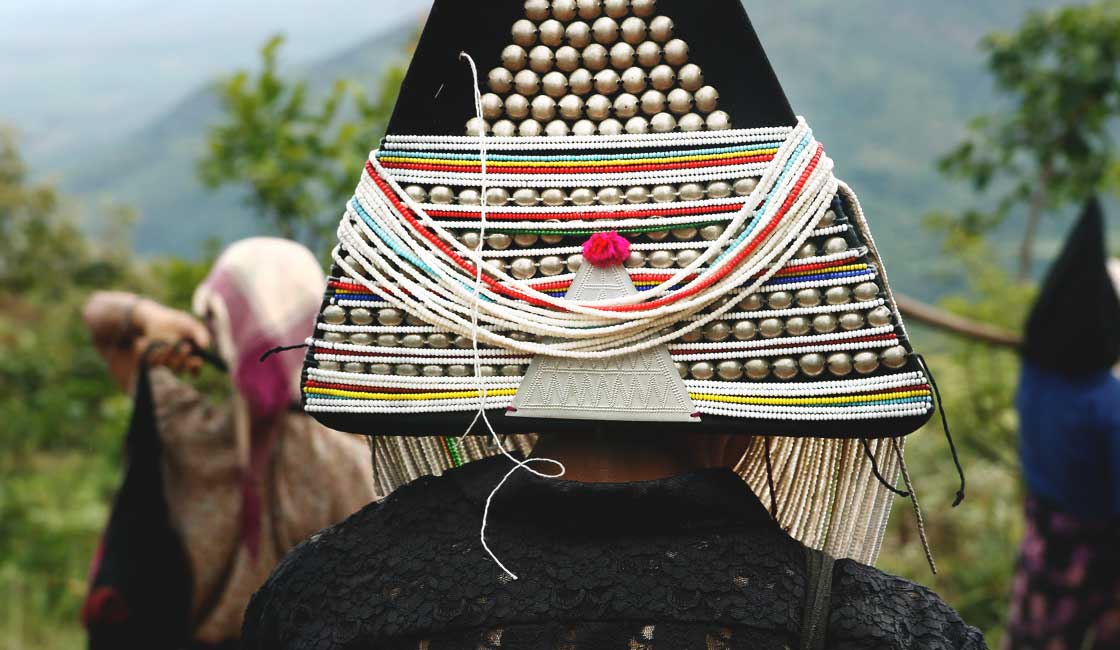
A trip to Myanmar is like visiting hundreds of different countries all rolled into one. With over 135 separate ethnic groups of Myanmar, each with its own different culture and customs, this is, without doubt, one of the most ethnically exciting places on Earth.
In recent years Myanmar (previously known as Burma), has emerged as an exciting new travel destination – full to the brim with a wealth of history and untouched cultures to witness. This beautiful country’s past may be fraught with conflict and complications, but it’s not hard to see why Myanmar has risen to the top of so many adventurous travelers’ bucket lists.
The main reason it is such a culturally rich part of the world to visit is down to the intricate web of ethnic minorities in Myanmar. The country borders five different nations of Southeast Asia (India, Bangladesh, China, Laos, and Thailand), not to mention the vast Bay of Bengal and the Andaman Sea that flank its southern side. This geographical position has gradually shaped Myanmar’s complex cultural make-up, leading to what is today one of the most ethnically diverse countries in the world.
Over the course of history, settlers have been drawn in from all sides, and today around one-third of the country’s population is made up of minority ethnic communities. If you were to look at a Myanmar ethnic group map, you’d see that the minority groups live on roughly half the country’s land. The country has certainly had a rough journey getting to where it is today, with civil wars and conflict between the tribes of Myanmar. In many places, the troubles are ongoing. However, it’s this diversity and fascinating past that makes the country so appealing to travelers.
So what does this hotchpotch history mean for the peoples of Myanmar today? Is the country still as culturally authentic as it once was? In what ways do the many Burmese tribes differ from one another, and how do they live now? Read on for answers to all these burning questions.
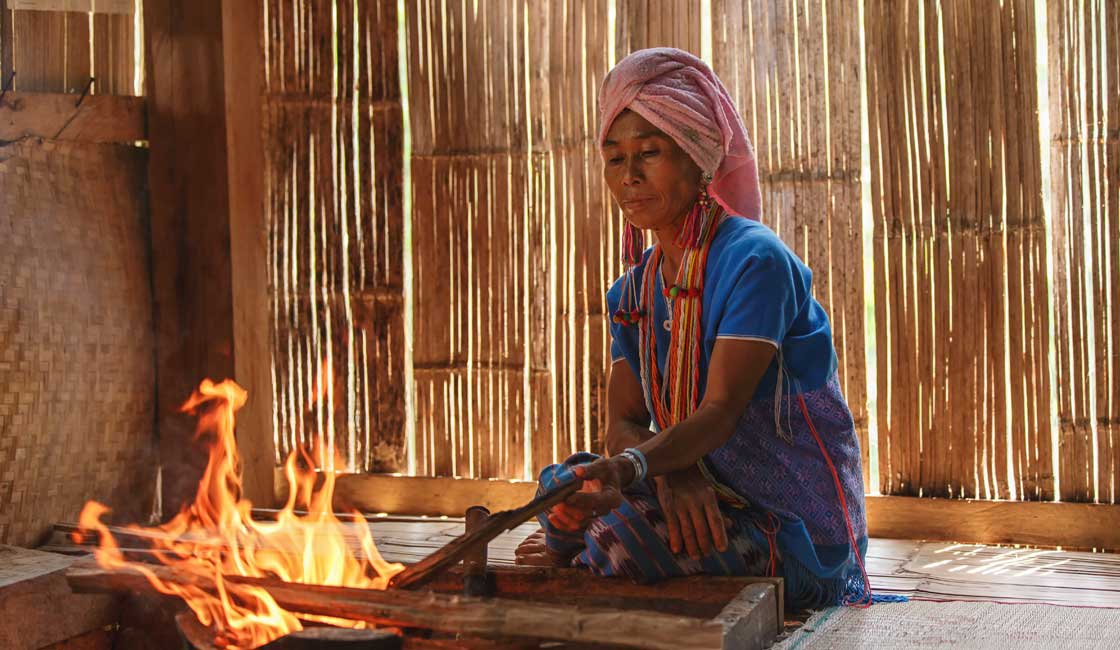
Hill tribes kitchen
The population of Myanmar numbers somewhere between 51 and 55 million people. Of this, around 68% are considered part of the dominant ethnic group – the Bamar (also known as the Burmans). Including the Bamar, the government of Myanmar acknowledges 135 separate ethnic groups in total. They speak over 100 different dialects and languages.
There is also a range of other ethnic groups that aren’t officially recognized by the Burmese government such as the Indian and Chinese populations and the Rohingya Muslims, among others. It’s thought that these unofficial tribes make up about 10% of the country’s population.
The 135 official ethnic groups are identified as belonging to eight categories called ‘major national ethnic races’ which are:
Unusually, these eight races are divided up not by language or genetic ancestry, but by geography – which has provided some confusion for many ethnologists. Apart from Bamar, each ‘major national ethnic race’ has its own state of the same name. Each of these comprises many different ethnic groups (except the Mon, which only has one), and many of the groups are very closely related. Confused yet? We don’t blame you!
It’s a complicated affair, and part of a much bigger conversation about how we put labels on ethnicities and cultures in general – something that stirs up no end of controversy. In fact, the ethnic minority groups of Myanmar choose to call themselves ‘ethnic nationalities’ rather than ‘ethnic minorities’ because of the increasing fear of being sidelined or steam-rollered by the dominant Bamar culture. This idea of cultural homogenization is often nicknamed ‘Burmanization’. For the sake of this article, we’re going to steer clear of too much of the nitty-gritty of debate, and dive into some of the recognized and unrecognized ethnic groups of Myanmar for an insight into how they live today.
It may be a little simplified but this map gives you an idea of the geographical spread of the various larger ethnic groups within Myanmar.
As you can see from the map, for the most part, the ethnic minorities of Myanmar live in the mountainous areas around the borders of the country. They have their own languages, traditions, cultural costumes, and religions that are fascinating to witness. People describe Myanmar as the ‘land of smiles’ mainly because of the warmth and hospitality of villagers in the rural parts of the country. Let’s have a closer look at some of the different ethnic groups of Myanmar.
The name Burma was given to the country during British colonial rule presumably after the ‘Bamar’, who were and remain to be the majority ethnicity in the country. Today, of course, the United Nations recognizes Myanmar as the country’s official name. The Bamar are a Sino-Tibetan ethnic group that takes up roughly two-thirds of the population of Myanmar at nearly 40 million people in total. Bamar people mostly live in the Irrawaddy River basin and are traditionally wet-rice farmers, having migrated here originally from Yunnan Province in China back in the 7th century.
The Bamar are where most widely-recognized elements of Burmese culture and identity are derived – such as their traditional clothing of long sarongs (longyi for the men and htamain for the women). On their feet, velvet sandals are worn (although leather and plastic are also used) – these are called gadiba phanat. Bamar women often put a yellowy white powder called thanaka onto their faces to protect their skin from the sun. For formal occasions, gold jewelry and silk scarves are put on, and the men often wear turbans and jackets with mandarin collars. Western clothing is making its inroads in the Bamar culture (t-shirts and jeans appearing more frequently) but not as much as in some other Southeast Asian cultures, and mainly in the country’s cities.
The traditional Bamar cuisine is normally rice, noodles, and fish with plenty of salad. They practice Theravada Buddhism which is a vital part of their culture, and they speak the Burmese language. Two important rites of passage take place to celebrate Bamar children coming of age – a Buddhist novitiate ceremony for the boys called shinbyu, and a ceremony of ear-piercing for the girls called nar tha. Festivals are popular, such as the regular pagoda festivals. Another interesting custom is the naming of Bamar children. This is done according to the day of the week the child is born – and the Burmese week is divided into 8 to include Yahu (Wednesday afternoon!).
The Bamar are actually made up of nine different ethnic groups in total, including one rather unique nomadic minority called the Moken. The Moken are made up of between 2000 and 3000 people that inhabit the waters around a group of islands called the Mergui Archipelago off the southern coast of Myanmar. They are often called ‘sea gypsies’ (or Salon in Burmese), living on wooden boats and leading a hunter-gatherer lifestyle, living completely off the sea. Their traditional fishing methods are still practiced today – they dive up to 60 meters to gather shellfish, and use a long pipe for oxygen. Isn’t that incredible?
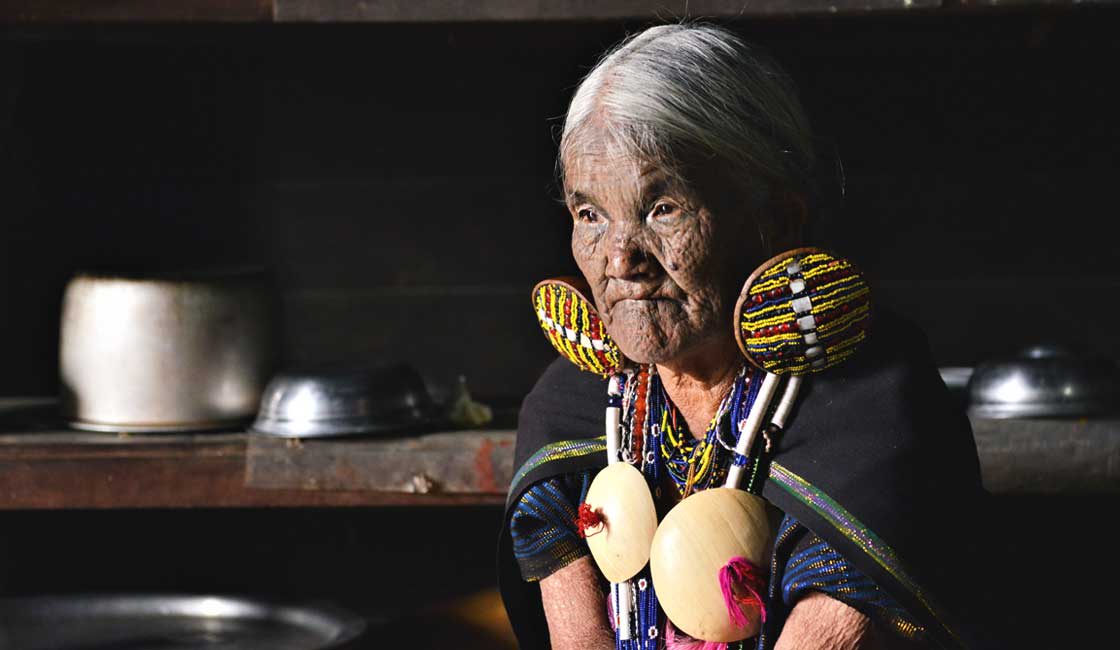
Chin State
The Chin is a large ethnic group made up of many different subgroups, speaking between 40 to 45 different dialects. They live up in Chin State, the remote mountains and thick forest of northwestern Myanmar, near the border of India and Bangladesh. The name Chin is thought to come from the Chindwin Valley, where they first entered Myanmar in the 9th century AD.
Their traditional dress is typically extremely colorful – mostly in red, green, and black although of course, this varies from tribe to tribe. On festival days such as Chin National Day (marking the day they officially gained human rights), they go all out with their costumes. Brightly colored, often patterned sarongs, held in place by gold or silver waistbands, together with as much jewelry as they can fit on! Rings, hairpins, necklaces, and bracelets, all play a large part in formal dress, and clothes are often adorned with bells, tassels, and shells.
The Chin were originally animist when it came to religion, but during the 19th-century, they were mostly converted to Christianity by Christian missionaries. They are known historically for their remarkable face tattoos – mainly given to women as a sign of beauty. Although something the Chin is intensely proud of, the practice of facial tattoos has today been banned by Burmese authorities and only a handful of Chin women have these ancient face tattoos today.
Sadly, it’s been said that the Chin are one of the most persecuted of Myanmar’s minority groups. In the period of the military junta, they were persecuted by the Burmese army, and tens of thousands of Chin fled to India to avoid the violence, which has created political tension between the two nations. They are also the poorest ethnic group in Myanmar with roughly 40 percent living without sufficient food, and 70 percent living below the poverty line. A big part of this food shortage is a series of unfortunate natural events that happened in 2006 where the bamboo forest in the region blossomed (which only happens roughly every 50 years!). Rodents were attracted and multiplied, drawn in by the fruit from the trees, which then ate their way through the local grain stores, forcing famine upon the Chin population.
The Kachin people make up the smallest of the ‘major national ethnic races’, inhabiting the Kachin hills in the north of Kachin State, as well as covering areas of China’s Yunnan province and parts of Northeastern India. People often interchange the name Kachin with the name of the principal subgroup – Jingpo (or Jinghpaw).
Traditional Kachin clothing is generally black, with silver adornments both for men and women. The women do sometimes wear colorful woolen skirts, and the men wear turbans – white for the youth, black for the elderly.
The Jingpo are notoriously deft at survival and fighting skills, along with craftsmanship and herbal healing. The Kachin State is known for its bountiful natural resources such as jade. Their huge buffalo-hide shields together with black varnished helmets adorned with boar tusks make a formidable sight. As with the Chin, the Kachin have been Christianized and today between one-half and two-thirds of the population are Christian (the remainder being mostly Buddhist and animist).
Also, like the Chin, the Kachin have had numerous armed conflicts over the past number of decades, as they fought for independence from Myanmar, until signing a ceasefire agreement with the Burmese government in 1994. However, this only lasted until 2011, and political and physical unrest is still rife in Kachin State. Currently, it’s not a recommended destination for travelers.
Down in the south and southeast of Myanmar, you can find Kayin State, where the Kayin or Karen people live. This ethnic group is made up of a large number of different sub-groups, many of whom don’t associate with one another and have little in common other than geographical location. It’s difficult to estimate how many there are of the Karen, as they are spread throughout Kayin State and beyond, but are thought to make up around 7 percent of Myanmar’s population. Most tribes can be found up in the mountains in villages between Myanmar and Thailand. A big part of Karen day to day life is music – women, in particular, can be seen in the villages playing guitar.
Like several other major ethnic groups, the Karen have been mostly at war with the government of Myanmar for over 60 years, seeking their independence. Their numbers are made up of Buddhists, animists and Christians, many of the latter suffering persecution and fleeing into neighboring Thailand.
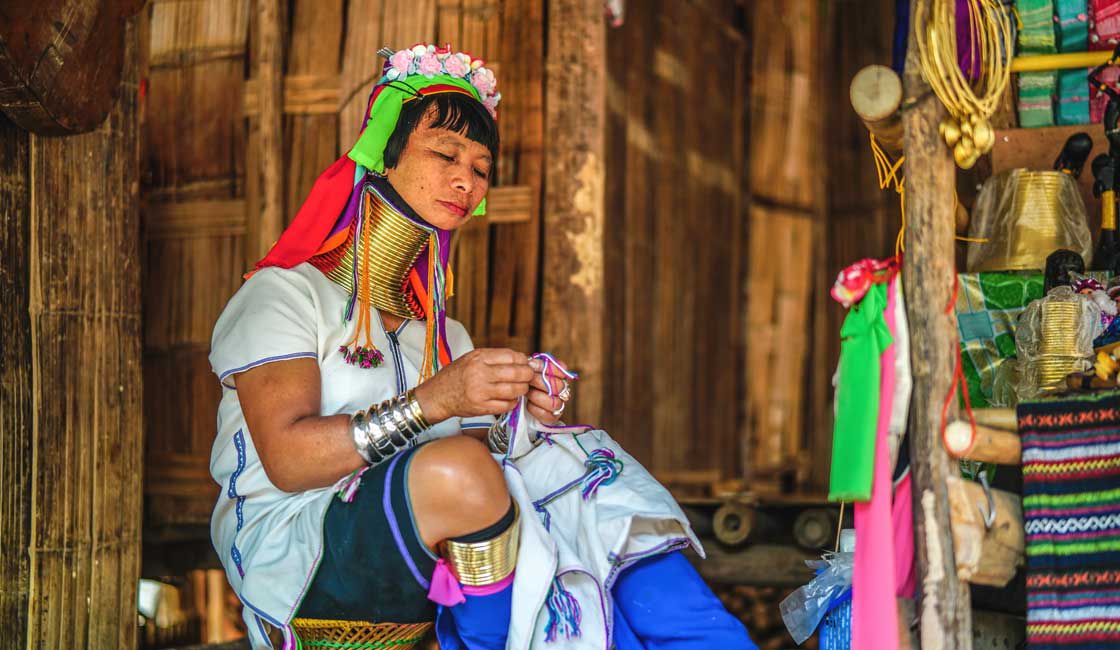
Long-neck Kayah woman
Closely related to the Kayin is the Kayah group of ethnic nationalities, also known as the Karenni or Red Karen. The Kayah inhabit Kayah State – a fairly small region found directly to the east of Myanmar, and the neighboring Shan State, as well as some parts of Thailand.
The most famous image of the Kayah is that of the ‘long-necked’ women that wear brass rings around their necks to give the illusion of having long slender necks. The small group that does this is known as the Kayan Lahwi or Padaung. They begin wearing these coils at the age of five and add more rings as the years go on. In reality, the coils do not stretch the neck itself but push down on the collarbone and rib cage. According to myth, this was first done to protect the necks from tiger bites! After the military regime in Myanmar banned the practices of certain tribal traditions such as neck rings and face tattoos, many Padaung fled over into Thailand. Today, however, not all women from these villages still wear rings, because they have become rather a spectacle for tourists.
Although today they are mostly a Christian ethnic group, part of Kayan tradition is their own religion called Kan Khwan which allegedly dates back to the Bronze Age. Tradition holds that communal Kayan decisions are done through divination – things like reading chicken bones or breaking thatch grass. They believe that the creation of the world occurred when god placed a stake in the ground.
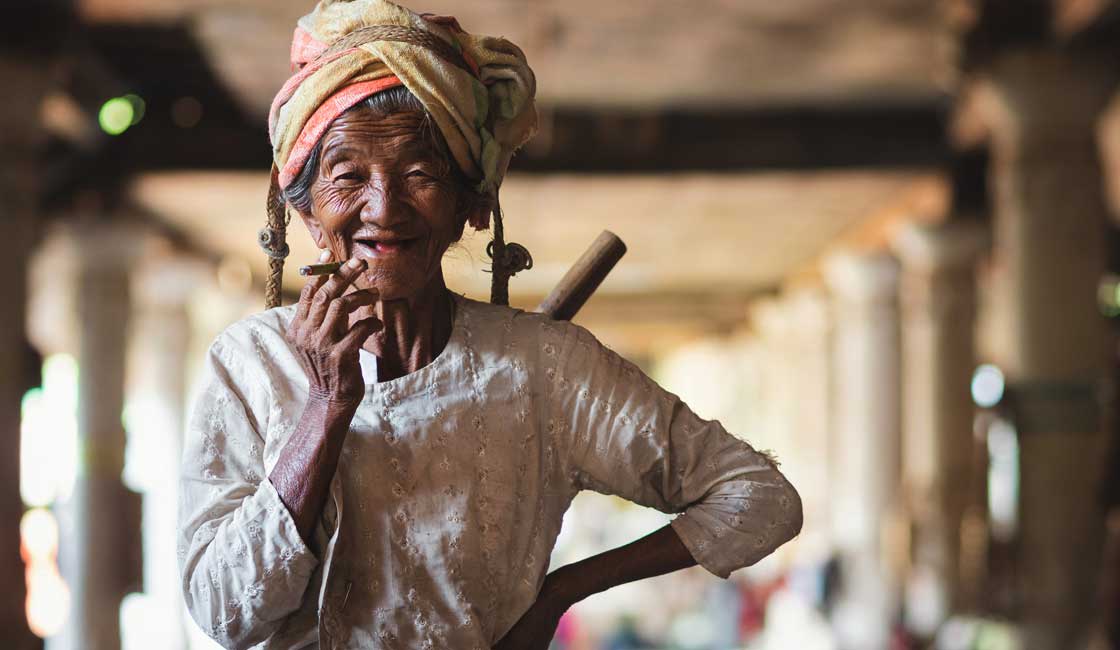
Shan State
The Shan (also known as the Tai Yai) is the largest ethnic group after the Bamar, making up over 9 percent of the population of Myanmar. This group encompasses many different ethnic minorities (approximately 33 in total), mostly living in the east and northeast of Myanmar.
The Shan are principally wet-rice farmers, but at one point Shan State was responsible for half of the world’s crop of opium! They mostly practice Theravada Buddhism, along with a Tai folk religion. They used to have a complex feudal system where they were ruled by hereditary princes.
Both men and married women wear turbans, and the color is an important part of growing up in Shan communities. Young girls start wearing brightly colored dresses at the age of 14, and as they get older, the outfits gradually become less colorful. The men on the other hand stick to dark blue baggy trousers. When women get to the age of 40, they start wearing black clothes which they then wear for the rest of their lives. In fact, older women of Shan communities tend to lose their own sense of identity as they get older – instead, they are referred to as the wife of someone, rather than a person in their own right.
Their living quarters are normally tall bamboo houses built on stilts. This is because the regions they inhabit are tropical rainforests, and this keeps them away from the damp ground. Beneath the house lives livestock such as pigs and chickens, and there are two water buckets at the bottom of the stairs to wash your feet in before you go enter the house – one for invited guests, and one for unexpected visitors. The balcony is the site of traditional Shan dancing, and there’s normally a shrine in the living room.
One of the subgroups of the Shan is the H’Mong, who are renowned for their textiles traditions of beautiful weaving and bright and colorful costumes. Tourists trekking through this region should keep an eye out for these artisanal crafts to purchase!
The Rakhine people are one of the largest ethnic groups in Myanmar comprising around 4 to 5 percent of the population. They’re closely related to the Bamar people but have adopted more Indian cultural influences because of the way the Myanmar mountain ranges isolate them from the rest of the country. They mostly live in Rakhine State which is on the western coast of Myanmar.
They’re also known as the Arakanese and are a truly ancient race that has been living in this part of Myanmar ever since 3,325 BC when the first independent Rakhine Kingdom was founded. Rakhine State is also home to the Rohingya Muslims, who have long faced persecution and are not recognized by the Burmese government as citizens of the country. The Rohingya are considered illegal immigrants from the Indian subcontinent, making them stateless, with no protective rights. Violence here is rife, particularly between the Rakhine and the Rohingya, and Rakhine State remains one of the poorest and most unstable parts of Myanmar.
Another major ethnic race in Myanmar is the Mon, which is made up of just one group as opposed to the many varying ones that comprise the other seven races. Around 2 percent of the population is Mon, and for the most part, they live in Mon State and other parts of the southern border, and there are many Mon in Thailand too.
It’s said that the Mon was one of the first people to settle in Southeast Asia, and for this reason, they’re credited with influencing much of Burmese culture today. It’s also believed that it was the Mon that brought Theravada Buddhism to the area, and today they still mostly follow this religion.
The Mon cultural symbol is a mythological water bird (that looks a bit like a swan) called the hongsa, commonly known as hintha. They have fantastic festivals and wonderful musical heritage, including traditional instruments such as the gong chime, the saung harp, and the crocodile xylophone! These instruments accompany their traditional dances which are performed in the villages.
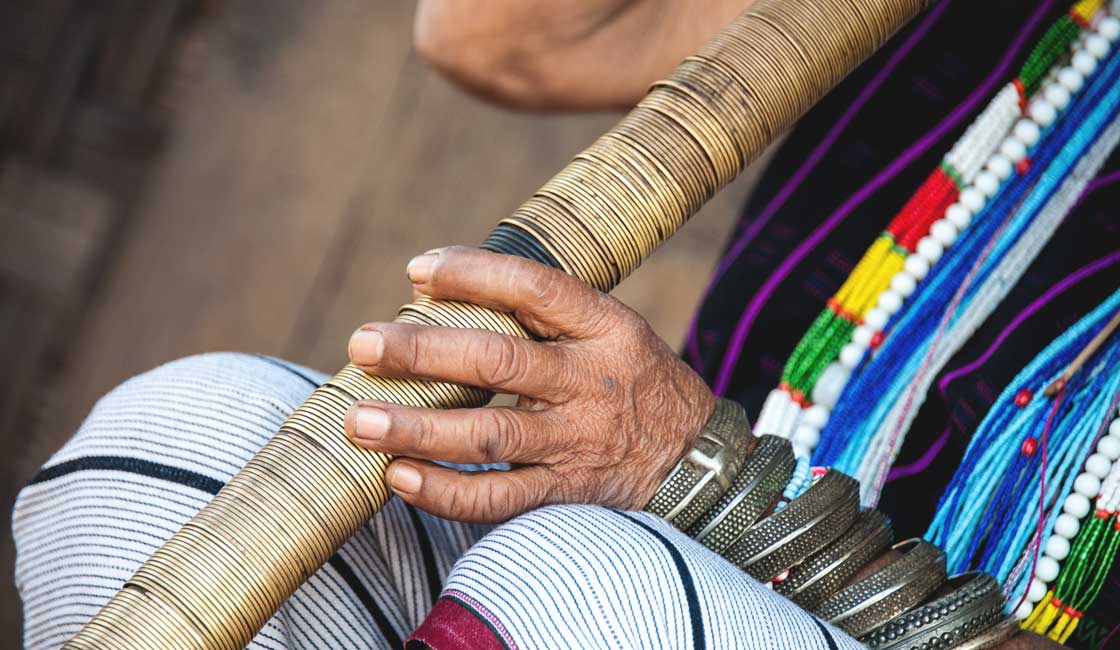
Still live traditions
Unlike some other Southeast Asian countries, the main issue that the ethnic minorities of Myanmar face is not from beyond its borders, but instead from within them. It’s important to remember that Myanmar has only been open to tourism itself very recently with the release of Aung San Suu Kyi, and the country is still emerging from military and political oppression, much of which is still ongoing. Minority groups fear becoming a monoculture and struggle (and in many places, physically fight) to protect their heritage and lands. Over the last 60 years and more, many ethnic minorities have tried to achieve independence from Myanmar, and this struggle is still going on in many places.
As well as the list above there are a handful of unofficial tribes that are not recognized by the Burmese government, including Burmese Indians, Rohingya, Anglo-Burmese, Lisu, Raway, Burmese Chinese and many more. Together, these stateless tribes make up around 10% of the people living in Myanmar.
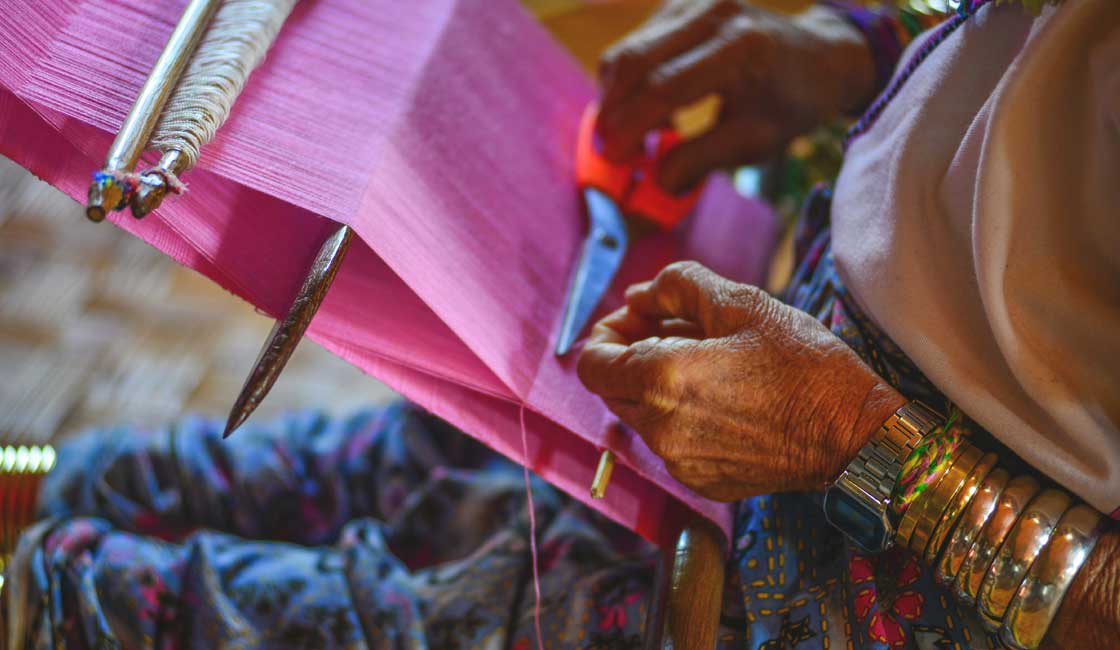
Weaving and selling goods
When visiting indigenous peoples, it’s important to remember a few key rules to make sure you don’t add any pressure to their lives. Remember that we are privileged to be permitted to visit this remarkable country and that sustainable tourism can play a largely beneficial role in shining a light on areas of the world previously in shadow. Here’s a quick checklist to ensure a happy trip:
So that wraps up our brief run-down of the different ethnic groups of Myanmar and the difficulties they face today. There is so much to learn from indigenous people around the world – if you’re planning a trip to Myanmar, prepare yourself for a tidal wave of color, sounds, smells, and culture.
While Rainforest Cruises aim to provide accurate and up-to-date information, we make no representations as to the accuracy or completeness of any information herein or found by following any link on this site. Rainforest Cruises cannot and will not accept responsibility for any omissions or inaccuracies, or for any consequences arising therefrom, including any losses, injuries, or damages resulting from the display or use of this information.




